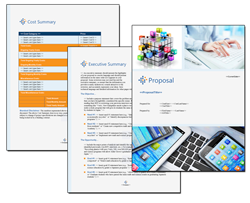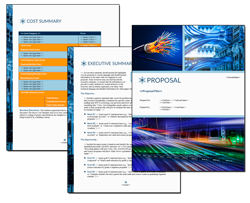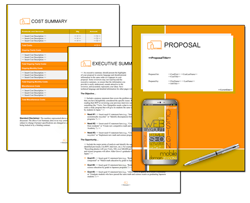
How to Write an Information Technology Business Proposal: Tips and Examples
Need to write an information technology business proposal but need help knowing where to start? This article will guide you through the essential steps. You'll learn to assess client needs, outline solutions, and structure your proposal to win business.
Key Takeaways
- An IT business proposal is a specialized document that presents tailored solutions to technology problems to persuade organizations to purchase IT-related products or services or fund a project.
- Critical components of a robust IT business proposal include an executive summary, client's needs analysis, proposed solution, project timeline and milestones, pricing and payment terms, and company overview and credentials.
- Best practices for creating winning IT business proposals include ensuring clarity and conciseness, using a professional design, following up, and avoiding common pitfalls like overloading with technical jargon and neglecting thorough proofreading.
Understanding an Information Technology Business Proposal
An Information Technology (IT) business proposal is designed to persuade organizations to purchase IT-related products or services. Unlike a business plan, which outlines a business's overall vision, strategy, and goals, an IT business proposal is a targeted pitch to a specific client. Its primary purpose is securing contracts, funding, or approval for IT projects by presenting solutions to potential clients' technology-related problems. The client or recipient of the proposal could be an executive for internal company project proposals or a lender for a funding proposal.

Business proposals are essential in the IT industry. They delineate IT projects' unique challenges and objectives and offer feasible plans to accomplish those goals. These proposals are customized to cater to client's specific requirements, demonstrating how your services or products can enhance their organization. This targeted approach sets IT business proposals apart from others, making them crucial for business success.
Writing a formal business proposal is more than just proposing a solution; it's also about showcasing why your business is ideally suited to aid potential clients and the specific assistance you can offer. This requires a deep understanding of the client's needs, a well-structured document, and a narrative that captures the client's attention from the start. To write a business proposal effectively, a well-written example proposal, such as one of the many IT-related example proposals in the Proposal Kit products, can serve as a guide to help you achieve these goals.
Key Components of an IT Business Proposal
The formulation of an effective business proposal necessitates several essential elements. These include:
- An executive summary
- A client's needs analysis
- A proposed solution
- A project timeline and milestones
- Pricing and payment terms
- A company overview and credentials
Each section contributes to constructing a thorough and convincing proposal that addresses every client's concern and exhibits your capability to fulfill their requirements.
Executive Summary
The executive summary is the heart of your business proposal and furnishes a concise pitch overview. Its primary goal is to summarize the value proposition and convince the recipient that your solution best fits their problem. This section should include relevant details about why you're sending the proposal, your goals and objectives, and the potential benefits of your proposed solution.
A well-written executive summary should:
- Be explicitly tailored to the client's needs, making it feel as though it was written just for them
- Typically, it is about two to four pages long, depending on the length of the entire proposal
- Be persuasive and engaging, and provide a clear roadmap of what the client can expect from your proposal.
Client's Needs Analysis

Grasping and expressing the client's needs is essential to any business proposal. This section outlines the challenges the client needs to address and the needs uncovered by your assessment. A specific problem statement should show a deep understanding of the client's challenges, demonstrating that you have thoroughly researched their situation.
Clearly defining the client's problem allows for a more tailored solution catering to their needs. This shows your expertise and reassures the client that you are the right choice to help them overcome their challenges.
Proposed Solution
The proposed solution section details the specific services or products you propose to tackle the client's problem. This section should outline the potential issues the client might face and provide detailed solutions and timetables for implementation. Clearly outlining the benefits of your proposal is crucial to avoid misunderstandings and to ensure the client understands the value you bring.
Moreover, it's essential to include timetables in this section to inform potential clients about the implementation timeline and expected results. This helps break up the text and makes the proposal more visually appealing and easier to understand.
Project Timeline and Milestones
A realistic project timeline is essential to demonstrating readiness and defining deliverables for the prospective client. This section should outline critical milestones and provide a step-by-step guide to the project's development process, ensuring the client knows what to expect at each stage.
The Proposal Kit's line item database feature lets you create project timelines, schedules, and financial pages.
Pricing and Payment Terms
Discussing various pricing models, like fixed price, time, and materials, allows clients to comprehend their choices lucidly. Providing clients with pricing options opens the conversation about their needs and offers a negotiable starting point rather than a set endpoint.
It's also essential to keep the proposal consistent with the service level agreement, and consulting a lawyer or your legal team is recommended when working on the terms and conditions section.
Company Overview and Credentials

The company overview and credentials section provides a platform to highlight your expertise, previous victories, and social validation. Sharing a brief story of your business can engage the reader and demonstrate your understanding of the client's needs. Highlighting your team's expertise acts as social proof and helps establish credibility.
Including a qualifications summary with case studies, customer testimonials, praise on social media, and endorsements from trusted experts can further enhance your proposal's persuasiveness. Ensuring clarity, relevance, and readability when explaining your achievements and social proof is crucial for making a solid impression.
Customizing Your IT Business Proposal
Tailoring your IT business proposal to cater to each client's needs can significantly enhance its potency. Here are some steps to follow:
- Research the client: Understand their industry, challenges, and goals.
- Personalize content: Use language and examples that resonate with the client.
- Address specific requirements: Clearly outline how your solutions meet their needs.
- Use visual elements: Incorporate charts, graphs, and images to enhance engagement.
By following these steps, you can create a tailored proposal that is more relevant and persuasive to your potential client.
Researching the Client

In-depth research about the client aids in tackling their unique challenges. Identifying the client's problem is crucial; you can use their website, annual reports, social media, and one-on-one interviews for insights. Defining the client's goals using SMART criteria helps align your proposal with their desired outcomes.
Additionally, assessing the client's current situation through SWOT analysis can reveal gaps your solution can fill. Researching the client's market, including customers, competitors, and industry trends, provides valuable context and helps you tailor your proposal to their needs.
Personalizing Content
Customizing the content of your proposal signifies a clear understanding of the client's precise needs. Customizing the problem statement to reflect the client's specific challenge shows that you understand their needs and are committed to addressing them. Aligning your solution with the client's goals and expectations enhances the relevance of your proposal.
Structuring the problem and solution pages by listing problem statements alongside detailed deliverables or focusing on one or two more significant problems and providing a list of solutions can make your proposal more engaging and easier to understand.
Using Visual Elements
Visual appeal plays a role in determining the effectiveness of a business proposal. Including visual elements can help break down information and make the proposal more engaging for the client. Charts and graphs can also break up text and illustrate points clearly in longer proposals.
Incorporating visuals such as infographics and charts can make complex data more accessible.
Tools and Templates for Writing IT Proposals
Proposal writing software and templates can simplify proposal creation, enhance productivity, and reduce redundant work. Business proposal templates are readily available with Proposal Kit and are crucial for streamlining the proposal writing process. Structured service proposal templates help ensure consistency and professionalism in your proposals.
 Proposal Kit Professional provides the most content, including legal contracts and a free design theme pack. Plus, advanced software features include custom branding and customizable quoting databases.
Proposal Kit Professional provides the most content, including legal contracts and a free design theme pack. Plus, advanced software features include custom branding and customizable quoting databases. Proposal Pack for Any Business covers this type of proposal and includes samples. There are also some commonly used specialty design themes available:
Proposal Pack for Any Business covers this type of proposal and includes samples. There are also some commonly used specialty design themes available:Photo Design Proposal Packs
 Proposal Pack Communication #4
Proposal Pack Communication #4 Proposal Pack Computers #5
Proposal Pack Computers #5 Proposal Pack Computers #6
Proposal Pack Computers #6 Proposal Pack Computers #7
Proposal Pack Computers #7 Proposal Pack Multimedia #5
Proposal Pack Multimedia #5 Proposal Pack Networks #4
Proposal Pack Networks #4 Proposal Pack Networks #5
Proposal Pack Networks #5 Proposal Pack Security #10
Proposal Pack Security #10 Proposal Pack Software #1
Proposal Pack Software #1 Proposal Pack Software #2
Proposal Pack Software #2 Proposal Pack Tech #8
Proposal Pack Tech #8 Proposal Pack Tech #9
Proposal Pack Tech #9 Proposal Pack Telecom #3
Proposal Pack Telecom #3 Proposal Pack Telecom #4
Proposal Pack Telecom #4 Proposal Pack Web #5
Proposal Pack Web #5 Proposal Pack Wireless #4
Proposal Pack Wireless #4
Proposal Kit Professional Bundle
The Proposal Kit Professional bundle is designed specifically for IT proposals.
The IT/Software/Hardware Contact Pack is a package of legal contract templates and software designd for IT projects.
The bundle features a Word add-in software wizard that works with multiple versions of Microsoft Word, offering:
- Built-in tutorials
- A quick start guide
- Output in formats such as Word, PDF, and HTML
- Proposal and contract templates for many types of IT projects
These tools provide valuable resources that can enhance the quality and efficiency of your proposals.
Best Practices for Effective IT Business Proposals

Adoption of best practices is critical to creating winning IT business proposals. These practices include clarity, conciseness, professional design, and a solid follow-up strategy. These elements ensure that your proposal communicates its key messages and leaves a lasting impression on potential clients.
Clarity and Conciseness
Clarity is paramount in an IT service proposal to guarantee the client's understanding of the offer. Avoiding overcomplicated language and focusing on clear and concise communication can significantly enhance the effectiveness of your proposal. Tools like Grammarly can help correct errors and improve content clarity and tone.
Being brief allows the content to speak for itself and makes it easier for the client to respond to questions. This approach not only makes your proposal more accessible but also more engaging.
Professional Design
A professional design is vital to boost the credibility and readability of your business proposal. Incorporating brand guidelines such as logos and brand colors creates a consistent and professional look. Including a table of contents makes the proposal scannable and easy to read for busy executives.
Effective use of white space enhances readability and ensures that the proposal does not appear cluttered. Customizing the proposal with company logos, custom graphics, and branding every page header can further improve its professional appearance.
Follow-Up Strategy

An effective follow-up strategy is critical to kick-starting further discussions and negotiations. Planning a follow-up strategy, such as a phone call or email, shows continued interest and addresses client questions.
Ensuring your communication is persistent without being pushy fosters positive engagement with potential clients.
Common Mistakes to Avoid
Identifying and avoiding common mistakes is vital to creating potent IT business proposals that connect with clients, including unsolicited ones. Common mistakes include overloading the proposal with technical jargon, ignoring the client's needs, and failing to proofread the document. These errors can make your proposal seem unprofessional and less compelling, reducing its chances of success.
Overloading with Technical Jargon
Using less technical jargon in your proposal can prevent clients from losing interest and misunderstanding the content. It can signal that you focus more on showcasing your expertise and ensuring the client's understanding. Opting for simpler alternatives to corporate jargon can improve clarity and avoid confusion, making your proposal more accessible to a broader audience.
Ignoring Client's Specific Needs

Ignoring the client's specific needs can make your proposal irrelevant and unengaging. Not personalizing proposals for each client can make them feel generic and less compelling. Highlighting the unique value proposition of your solution over just the price can make your proposal more appealing to clients.
To ensure relevance, thoroughly research the client's business, industry, and specific challenges before writing your proposal. This personalized approach demonstrates a deep understanding of the client's needs and increases the likelihood of proposal acceptance.
Lack of Proofreading
Failing to proofread your proposal can lead to typos and grammatical errors, significantly undermining its professionalism. Grammatical errors and typos can detract from your key messages and make your proposal seem rushed and unpolished.
Proofreading ensures that your key messages are communicated clearly and effectively, enhancing the overall quality of your proposal.
Here are some related samples included in every downloadable Proposal Pack
The AI Writer generates a first draft of these templates - customized to your company, client, and project - in just minutes, giving you a head start on editing. Get any Proposal Pack or Proposal Kit Professional, and all of these samples, and the AI Writer are included.
- Large Web Site and CD-ROM Project
- CD-ROM Development Proposal
- Small Business Web Site Project Proposal
- Micro Web Site Project Proposal
- Micro PowerPoint Project Proposal
- CD-ROM Marketing Materials Creation Proposal
- IT Product and Service Sales Proposal
- Technology Consulting Sample Proposal
- Technology Business Plan Sample
- Multilingual Web Site and DVD Sample Proposal
- Software Automation Sample Proposal
- Web Site Creation and Software Integration Project
- DOJ Federal Government Grant Proposal
- DOJ Federal Government Grant Proposal #2
- USDA Federal Government Grant Proposal
- Process Improvement Sample Proposal
- Training Services Sample Proposal
- Software and Hardware System Sample Proposal
- Employee Security Card Sample Proposal
- Network Cabling Sample Proposal
- Web Hosting Business Plan Sample
- Business Continuity Services Sample Proposal
- SEO Services Sample Proposal
- Electronic Medical Record System Sample Proposal
- Patenting New Technology Sample Proposal
- Selling a Web Site and Digital Assets Proposal
- Website Advertising Offer Sample Proposal
- Electronic Records Management Sample Proposal
- Records Management Analysis Sample Proposal
- Records Management Survey Analysis Sample
- Internet Cafe Startup Funding Sample Business Plan
- 3D Printing Prototyping Services Sample Proposal
- Artificial Intelligence Project Sample Proposal
- Smart Home Automation Project Sample Proposal
- Intellectual Property Licensing Sample Proposal
- Robotics Automation Project Sample Proposal
Here are some related downloadable templates
The AI Writer generates a first draft of these templates - customized to your company, client, and project - in just minutes, giving you a head start on editing. Get any Proposal Pack or Proposal Kit Professional, and all of these templates and the AI Writer are included.
- Android App Development Proposal Template
- App Development Proposal Template
- Blockchain Proposal Template
- Broadband Services Provider Proposal
- Building a Computer Network
- Cloud Computing Services Proposal
- Cloud-based Asset Tracking Project Proposal
- Custom Software Development Proposal
- Data Center Migration Proposal
- Drone Mapping and Survey Services Proposal
- EMV Chip and Pin Migration Proposal
- ERP (Enterprise Resource Planning) System Proposal
- Electronic Medical Record System Proposal
- IT Disaster Recovery Services Proposal
- IT Equipment Maintenance and Repair Services Proposal
- IT Operations Finance Banking Proposal Template
- IT Product and Service Sales Proposal
- Cloud Computing Project Proposal Template
- Computer Repair Proposal Template
- Digital Product Sales Proposal Template
Summary
Creating an IT business proposal requires a deep understanding of the client's needs, a clear and concise communication style, and a professional design. You can make a persuasive and effective proposal by focusing on critical components such as an executive summary, client's needs analysis, proposed solution, project timeline, pricing, and company credentials. Tailoring each proposal to the specific client and avoiding common mistakes will enhance its impact. With these strategies, you can confidently create proposals that meet and exceed client expectations, paving the way for business success.
Frequently Asked Questions
What is the purpose of writing a business proposal?
Writing a business proposal aims to persuade potential clients or stakeholders to support your idea, project, or business endeavor. It aims to secure contracts, project approval, or funding for a new venture.
How should a proposal be tailored to a specific client?
To tailor a proposal to a specific client, gather information about their requirements, and create a customized proposal based on their needs.
What sections should be included in a business proposal?
A business proposal should include an introduction, a summary of the client's needs, a description of products/services and costs, and information about the organization, credentials, and capabilities. These sections provide a comprehensive overview of the proposal's content and the organization's capabilities.
What should be included in the last section of a proposal?
In the last section of a proposal, include pages that instill trust in the prospective client by describing the organization, skills, experience, and information from other clients.
How can the proposal writing process be sped up?
You can speed up the proposal writing process using pre-designed templates that offer guidance and examples for the content you need.



 Cart
Cart
 Are you just looking for a template, sample, or software for your information technology proposals? Click these links to skip down the page and get right to it.
Are you just looking for a template, sample, or software for your information technology proposals? Click these links to skip down the page and get right to it.

 Facebook
Facebook YouTube
YouTube Bluesky
Bluesky Search Site
Search Site